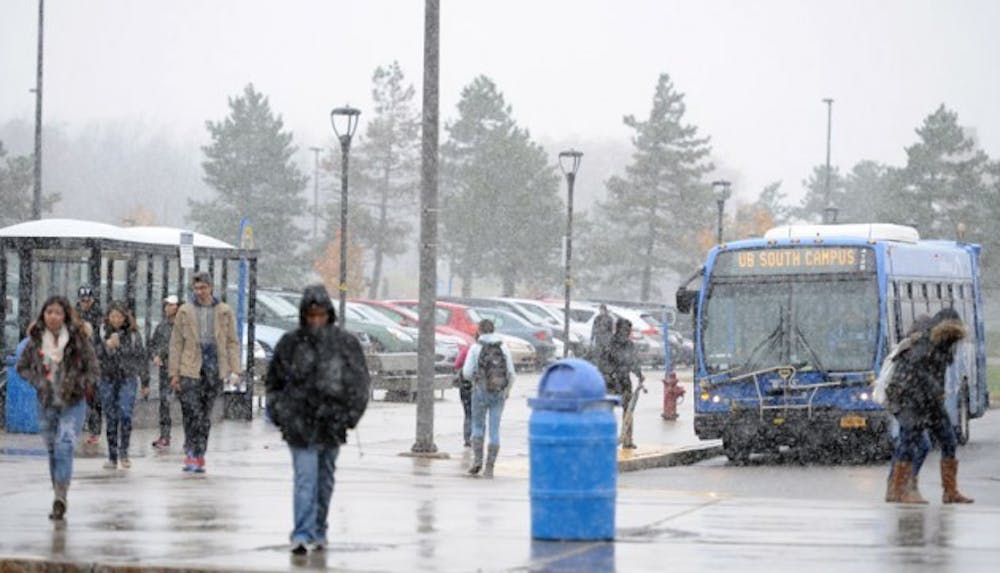While most UB students were happy to spend a few months away from the cold this summer, William Philipps spent his summer at the ice sheets of Svalbard, a Norwegian group of islands. Now, he uses his knowledge from the trip to understand the coming “polar vortex.”
Polar vortex – a term that makes many Western New Yorkers groan – refers to a cluster of cold air located at the poles. Buffalonians experienced its wrath last year, and the Queen City is expected to be hit again this winter, among other areas across the United States. With the first real snowfall of the year Thursday, the topic of the looming chill of the vortex is on the minds of many people in Buffalo.
But most people aren’t as educated on the topic as Philipps. He studied the changes in ice glaciers in the Northern Hemisphere and climate dynamics with The University Centre, a Norwegian state-owned company that provides university-level education in arctic studies. One of these processes was the polar vortex.
The vortex was dislocated by high pressures from the Pacific Ocean last year and found its way to some parts of United States and Canada, causing extreme subzero temperatures.
Philipps, a second-year geology graduate student, studied the history of the ice sheets that stretch from Svalbard to Barents Sea. This region contains several islands in between Norway and the North Pole. He said his work on the history of the west Antarctic ice sheet would potentially help to predict the future activity in this region.
He said his research team doesn’t sensationalize the issue of the polar vortex as he feels the current media does, but they try to understand the topic.
“This phenomenon is not new and has been talked about in our field for long time,” Philipps said. “We can summarize it by saying polar vortex is caused by the warming of atmosphere that effects how wind currents go around the globe.”
Dale Gump, a second-year geology graduate student, is Philipps’ fellow student researcher. Gump said as geologists, they try to understand polar vortex and other climate events from a scientific viewpoint. They look at the past, evaluate the present and hypostasize the future.
Philipps said any local climate event has a place in the globe’s climate system. He said whatever is happening in Buffalo is linked with events at different parts of the globe.
Buffalo recorded 129.9 inches of snowfall in its last winter season, making it the seventh snowiest winter season in Buffalo’s history.
With the result of more snow, Dr. Jason Briner, an associate professor and director of the paleoclimatology lab in the geology department, does not want the public to perceive polar vortex as only cold weather. He said while last year Buffalo had one of its colder winters, Alaska had a warmer winter. He said the public should not mistake the cold weather as a sign that global warming isn’t happening.
Gump said the polar vortex is in our and the media’s attention.
“We look for present day climate change and we look for changes in proxies [variations] in order to evaluate present based on past,” Briner said.
He said the polar vortex is most likely due to drastic temperature changes in the poles.
“When wind belts are running efficiently, they keep the cold, hot and warm air clusters in place like a fence, so it’s hard for air flows, like polar vortex, to escape,” Briner said. “But when the wind belt is weak, jet stream[s] start to get wavy and break down. That’s when arctic air comes to Buffalo.”
The temperature changes happen when jet streams, which are airflows, become unstable when the north and south poles warm faster than other parts of the world. Wind belts circulate the globe and keep cold, warm and hot air where they are supposed to be.
Briner said when the poles become warmer than other parts of the globe, the arctic temperatures weaken the polar vortex. Unstable jet streams then send cold and warm air to other directions, making some areas in the globe colder or warmer than normal.
“It depends on which air flow is sent toward that area as a result of redistributed air waves,” he said. “When polar vortex visits here, it makes Buffalo cold, but when it visits Alaska, it means warmer weather for that region.”
Briner said in 2012, the United States had the warmest year in 118 years and the sea ice amount was at its lowest record.
“However, the next year, in 2013, U.S. experienced an extremely cold winter while rest of the world rather had a warmer year,” he said. “It is important to note these changes in a big picture, not only in local scale.”
Sandra Cronauer, a research technician at Briner’s paleoclimatology lab, said despite what we may read and hear on the news, the explanation of current climate events cannot be easily defined.
“Change in the ecosystem has always been dynamic,” she said. “Changes are not easy to constraint and there can be many explanations for current climate events. It’s difficult to interpret the information we learn via media when you read them from scientific viewpoint.”
email: news@ubspectrum.com





